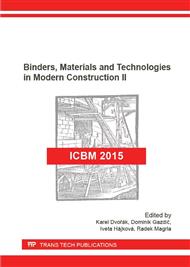[1]
Biedermann, F., Oberrnberger, I., Ash-related problems during biomass combustion and possibilities for a sustainable ash utilisation. In Proceedings of the International Conference World Renewable Energy Congress (WREC), Aberdeen, Scotland, Elsevier Ltd., Oxford, UK.
Google Scholar
[2]
Van Loo, S., Koppejan, J. (eds. ). The handbook of biomass combustion and co-firing, London. Earthscan. 2008. ISBN: 978-1-84407-249-1.
Google Scholar
[3]
Khestl, F., Šulková, V. and Mec, P. Use of Glassy Slag from Biomass Combustion in the Building Industry – Coarse Aggregate. Advanced Materials Research. Vol. 1122, 2015. pp.219-224.
DOI: 10.4028/www.scientific.net/amr.1122.219
Google Scholar
[4]
Khestl, F., Mec, P., Turicová, M., Šulková, V. Slag from biomass combustion (BCS) – chemical properties in accordance with BCS utilization in cement concrete. Advanced Materials and Structural Engineering: Proceedings of the International Conference on Advanced Materials and Engineering Structural Technology (ICAMEST 2015). CRC Press. ISBN 9781138027862 (in print, January 2016).
DOI: 10.1201/b20958-45
Google Scholar
[5]
Černý, V.; Keprdová, Š. Usability of fly ashes from Czech Republic for sintered artificial aggregate. Advanced Materials Research, 2014, vol. 2014, no. 887- 888, pp.805-808. ISSN: 1022- 6680.
DOI: 10.4028/www.scientific.net/amr.887-888.805
Google Scholar
[6]
Černý, V. Utilization of bottom ash for sintered artificial aggregate. In ICEBMP 2014. Advanced Materials Research. Switzerland: Trans Tech Publications, 2014. pp.170-173. ISBN: 978-80-87397-16- 9. ISSN: 1022- 6680.
DOI: 10.4028/www.scientific.net/amr.1000.170
Google Scholar


